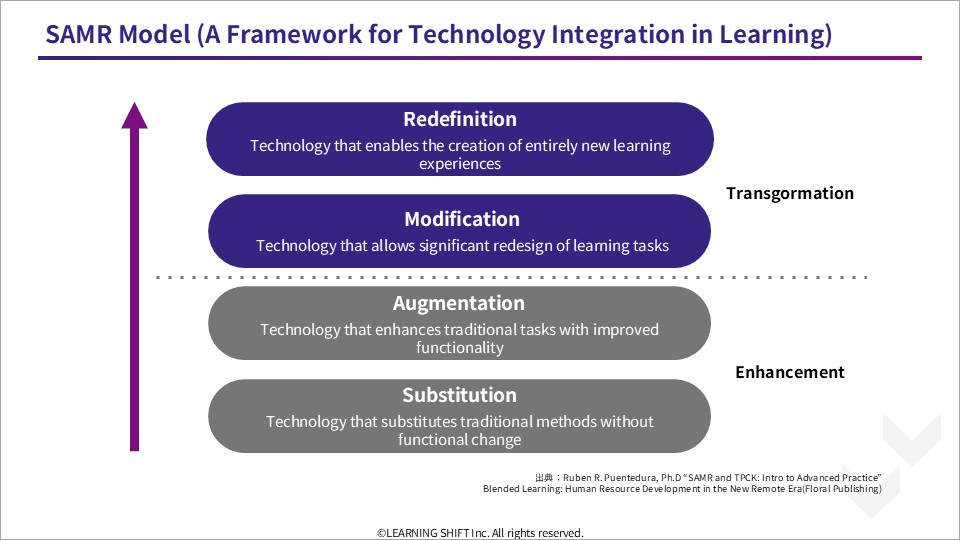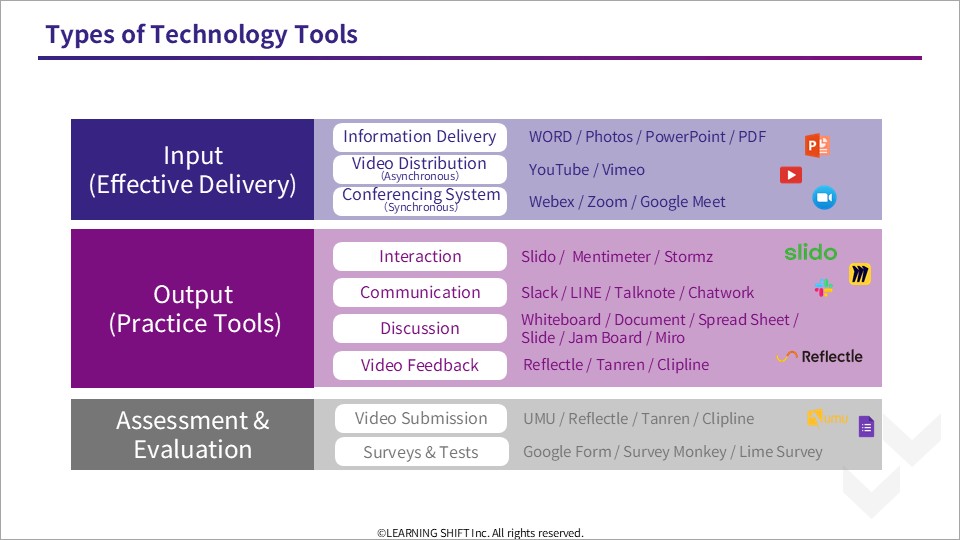2022.02.12
Technology Knowledge for Next-Generation Training Design: Importance and Practical Applications

With the advancement of technology, numerous learning tools and platforms have emerged, offering the potential to enhance learning outcomes. However, achieving these benefits depends on how well technology is applied.
For those responsible for talent development, mastering Technology Knowledge (TK) is essential for designing successful training programs.
This article explains the concept of Technology Knowledge in corporate learning and provides practical strategies for leveraging technology effectively.
(1) What is Technology Knowledge?
Technology Knowledge (TK) is one of the core elements of TPACK, alongside Content Knowledge (CK) and Pedagogical Knowledge (PK). It refers to understanding technology and how to apply it effectively in corporate training.
In a corporate training context, technology encompasses web-based services, digital tools, and learning management systems (LMS), all of which serve as key learning delivery methods.
Over the years, computers, smartphones, and tablets have revolutionized learning delivery. As a result, the evolution of corporate training is closely linked to technological advancements. With the rise of Digital Transformation (DX), modern corporate learning now requires a more integrated and adaptive approach to training design.
The Association for Talent Development (ATD), a global leader in talent and organizational development, has periodically updated its competency model (renamed the ATD Capability Model in 2019).
Notably, the 2013 version of this model highlighted “Learning Technology,” but by 2019, it had shifted to “Learning Application.”
This change signifies that talent development professionals must not only understand learning technologies but also develop the capability to apply any type of technology to enhance learning.
With countless new technologies emerging across various industries, talent development professionals must cultivate the ability to identify, adapt, and integrate these tools into corporate learning environments.
(2) Why is Technology Knowledge Becoming More Important?
Before discussing the significance of Technology Knowledge (TK), let’s first explore how technology impacts learning outcomes.
As Digital Transformation (DX) continues to expand, one frequently referenced model is the SAMR Model.

The SAMR Model categorizes technology integration into four levels:
①Substitution (S)
②Augmentation (A)
③Modification (M)
④Redefinition (R)
It presents a hierarchical framework—moving from (1) to (2) to (3) to (4)—that categorizes how technology is used.
Each stage represents a different level of technological integration and serves as a reference point for understanding the impact of technology, particularly when considering digital transformation (DX) as a whole.
Although the SAMR model is not limited to learning contexts, it has become widely used as a framework for exploring how technology significantly influences learning outcomes.As just one example, when we apply the SAMR model to learning-related DX, we can interpret it in the following way:
| Stage | Definition | Example |
| ① Substitution | Using technology to replace traditional methods | Replacing in-person training with Zoom sessions |
| ② Augmentation | Using technology to enhance learning reach | Using an online conferencing system to train 1,000 participants |
| ③ Modification | Redesigning learning structures with technology | Shifting from one-time training to pre-training, live discussions, and follow-ups using Zoom |
| ④ Redefinition | Enabling entirely new learning experiences | AI-powered role-playing simulations with automated feedback |
Of the four stages, Substitution and Augmentation are classified under Enhancement, while Modification and Redefinition fall under Transformation.
- Substitution & Augmentation are categorized under Enhancement, where technology reinforces existing learning processes.
- Modification & Redefinition fall under Transformation, where technology reshapes learning methodologies to create new value.
True technology integration happens at the Modification and Redefinition levels. Simply digitizing traditional training methods does not fully leverage technology’s potential.
For example, replacing classroom training with online webinars represents only Enhancement. However, blending in-person and online components to create pre-learning, post-learning, and follow-up discussions signifies Transformation.
Thus, while technology is crucial, simply adopting new technology does not automatically result in better learning outcomes. Instead, the key lies in strategically applying technology to enhance learning effectiveness.
This is why Technology Knowledge is gaining greater importance—it provides a structured approach to leveraging technology as a means to improve training rather than adopting tools for the sake of using new technology.
(3) The Three Types of Technology Blends in Training
A core principle of Technology Knowledge is the blending of three key types of technology. This approach involves categorizing technology based on its learning application and integrating the most suitable tools for each training need.
Corporate learning typically involves three types of content:
- Input (Knowledge Acquisition)
- Output (Practice & Application)
- Evaluation (Assessment & Measurement)
Similarly, technology tools can be mapped to these categories:

Here is a brief explanation of training tools, categorized by their purpose.
#1. Information Delivery Tools
These are the most basic input tools, used primarily to deliver information.In addition to traditional tools like PDFs and PowerPoint, online platforms such as note and Notion are increasingly being used for content sharing.
#2.Video Distribution Tools (Asynchronous)
As the name suggests, these tools are used to distribute video content. They are well-suited for asynchronous training due to their low cost and ease of saving and sharing content.
#3. Meeting Systems (Synchronous)
These tools are useful when you want to conduct activities in real time.
Meeting systems typically include features suited for synchronous online sessions, such as group work, group discussions, whiteboards, chat, and breakout rooms.
#4. Communication Tools
These tools are commonly used in daily work, but because they facilitate communication with others, they are also useful for learning.
They can be used for team-based communication, post-training discussions, and sharing recommended resources.
#5. Interaction Tools (Synchronous)
Interaction tools are especially suitable for synchronous training because:
In addition to communication, they allow real-time comments, polling, and survey result sharing.
Even with 1,000 participants, learners can share what others nearby—or remote—are thinking and feeling in the moment.
#6. Discussion Tools (Visualizing Conversations)
These tools help visualize and share discussion content using diagrams or text, which encourages active dialogue.
Some tools allow all participants to write and collaborate on the same shared space in real time.
#7. Survey Tools
Survey tools are essential and highly practical in training settings.
They are mainly used for:
・Content evaluation
・Pre-training interviews
・Engagement diagnostics
・Assessments
・Needs surveys
These tools are convenient as they streamline everything from collection to analysis.
#8. Video Feedback
Video feedback tools are used as practice aids to strengthen output.
They include features such as video recording, sharing, commenting, and peer feedback.
As shown, there are many types of technology tools suited to different types of content.
To maximize content effectiveness, it’s essential to follow the steps of understanding, mastering, and combining the right tools.
(4)Practical Strategies for Applying Technology in Training
From the explanations so far, you might think that technology should be used differently depending on the purpose of the content.
That’s partly true—but it’s important to note that this doesn’t mean “one tool for one purpose.”
Using different tools for the same purpose or goal increases the number of tools in use, and the variety is likely to grow even more in the future.
If you select tools based only on their main functions, you may end up with too many, making them harder to manage and potentially lowering learner motivation.
For these reasons, when applying technology, it’s best to fully utilize a single tool whenever possible.
Two key strategies for applying technology effectively:
- How to combine tools
- How to expand the use of a tool
#1. How to Combine Multiple Tools
While using a single tool is ideal, training often requires multiple tools working together to enhance the learning experience.
For example, integrating Zoom (for live interaction) with Miro (for collaborative brainstorming) offers:
- A seamless integration of video conferencing and real-time collaboration
- Enhanced whiteboard functionality beyond Zoom’s built-in features
- Expanded accessibility via free-tier tools
By selecting complementary tools, organizations can optimize training efficiency and user experience.
#2. How to Expand the Use of Existing Tools
Instead of adopting numerous new tools, talent development professionals should maximize the potential of existing tools.
For instance, Zoom includes features such as:
- Chat and messaging
- Address book integration
- Built-in whiteboard functionality
Similarly, Google Sheets, primarily a spreadsheet tool, can be used to organize group discussions and track breakout session insights.
By deeply understanding a single tool’s capabilities, trainers can reduce reliance on multiple platforms and streamline learning experiences.
(5)Conclusion: True Technology Utilization for Future Learning!
To fully leverage technology, training professionals must go beyond merely adopting the latest tools. Instead, they should focus on strategically blending and applying technology to enhance learning outcomes.
By mastering Technology Knowledge, organizations can design more effective, scalable, and engaging training experiences while optimizing resources and improving learner engagement.